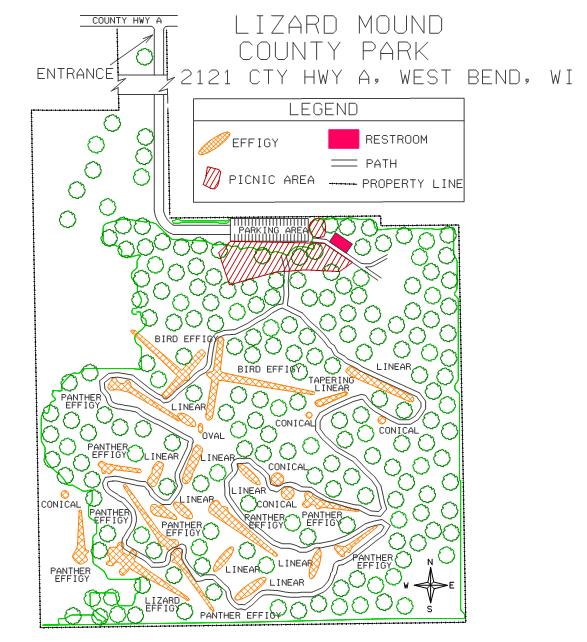Lizard Mound County Park
(Hagner Group)
National Register of Historic Places
Lizard Mound County park is considered one of the best-preserved sites of its kind in Wisconsin. There are currently 28 mounds in
the park, although sometimes the number 26 appears in literature - either typo or because at least one (possibly two?) of the mounds
turned out to be of natural origin rather than human-built. Sometimes you'll come across the number 29 too. It's estimated that the
original group consisted of about 60 mounds, although as early as 1883 only 47 were documented, and more were lost to cultivation
ever since. As of today the map shows 5 conicals, 1 oval, 10 linear or tapering linear mounds, 1 lizard, 2 birds and 9 panthers or
water-spirits, including pared effigy - two panthers connected head-to-head.
Today, the Lizard Mound County Park has its own entry in the National Register of Historic Places, although it's a part of broader
Washington County "Island" Effigy Mound Archeological District, also included in the Register. It's unclear if there are more mounds
surviving on surrounding private lands, most of which are pasture, but there are some names associated with the Archeological District,
in particular Glass Mounds and Susan/Backhouse Mounds.
The mounds are generally in good condition, the greatest concern being large trees, some at the end of their life spans, growing over
the mounds. What's unusual about this group is that the mounds are covered with mosses, basically absent from surrounding forest
floor. I couldn't find any information regarding this phenomenon, but it's possible that the mounds are covered with acidic soils, brought
from somewhere else that don't support any other vegetation, except for very few small forbs. Compactness of the soil and insufficient
sunlight are the factors too. Mounds in other areas are constantly overtaken by shrubbery and large forbs, needing periodical cleaning
and maintenance. The other factor to take into account is that this group sits in the very good quality mesic forest with very clean
understory level with basically no invasive plants at all, except for some garlic mustard. The other interesting feature of this mound
group is its location, with no lakes or rivers nearby. But the site used to be surrounded by springs, and it's not unusual for Native
Americans to have constructed mounds near springs that played prominent role in their culture and mythology.
The descriptive tablets along the mile long trail are aged and some are missing.
The photos above this text are from about 10 years ago. I revisited this park in late 2020, and photos below reflect some of the changes.
About half of the park has been completely revamped - many canopy trees removed and mounds are apparently seeded with grass. Interpretive center with Mound display under the roof was installed, as well as interpretive signs along the path near the gazebo.

